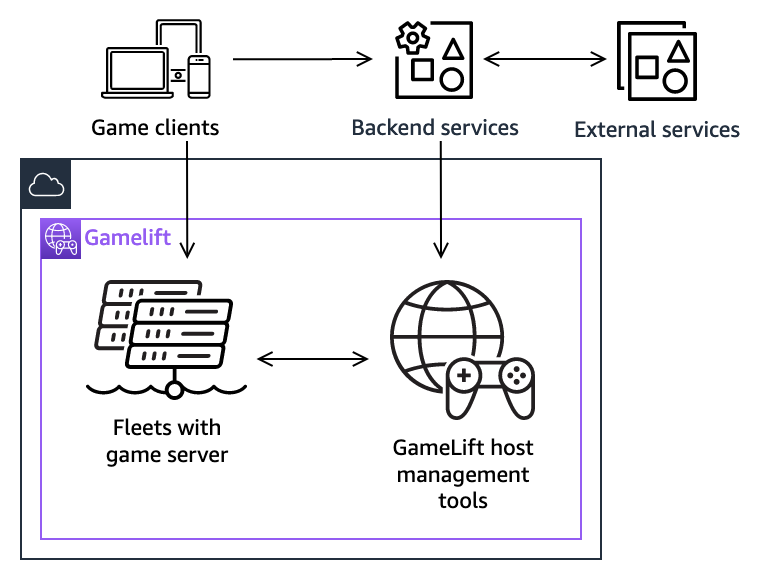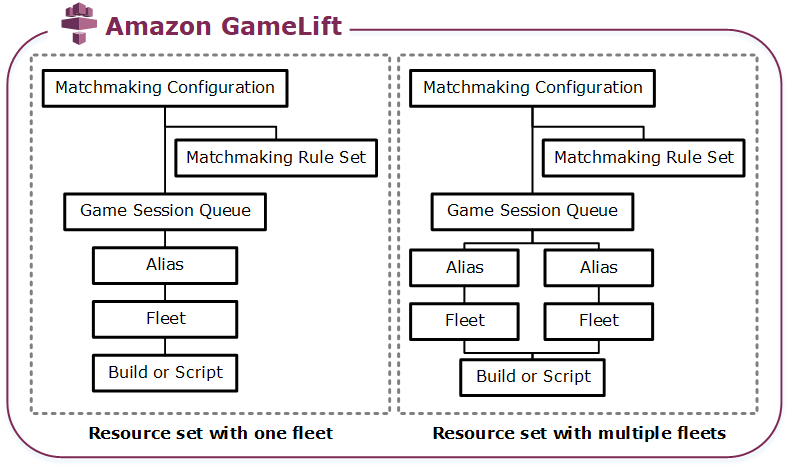本文属于机器翻译版本。若本译文内容与英语原文存在差异,则一律以英文原文为准。
托管Amazon GameLift Servers解决方案架构
本主题中的图表概述了完整的托管解决方案Amazon GameLift Servers是如何构造的。
带托管的游戏组件
下图说明了Amazon GameLift Servers托管主机解决方案的关键组件如何协同工作以运行专用游戏服务器并帮助玩家查找和连接托管的游戏会话。您为游戏开发的托管解决方案将包含大部分或全部这些组件。

架构包含以下关键组件:
- 游戏客户端
-
游戏客户端是指玩家设备上运行的软件。玩家通过加入托管的游戏服务器上的游戏会话来玩游戏。游戏客户端通过后端服务请求加入游戏会话,接收游戏会话的连接信息,然后利用该信息直接与游戏会话连接。有关更多信息,请参阅 正在为游戏做准备 Amazon GameLift Servers。连接到Realtime服务器时,A 游戏客户端使用客户端 SDK Amazon GameLift Servers Realtime。
- 后端服务
-
后端服务是您创建的自定义服务,用于代表游戏客户端处理与该Amazon GameLift Servers服务的通信。后端服务也可用于游戏特定任务,例如玩家身份验证和授权、库存或货币控制。后端服务使用 Amazon 软件开发工具包中的 API 操作与该Amazon GameLift Servers服务进行通信。
后端服务会发出获取现有游戏会话信息和启动游戏会话的请求。对新游戏会话的请求定义了某些特征,例如最大玩家数。这些请求会提示Amazon GameLift Servers您开始游戏会话放置过程。当游戏会话准备好接受玩家时,后端服务会检索连接信息并将其提供给游戏客户端。
- 外部服务
-
您的游戏可以依赖外部服务,例如用于验证订阅成员资格。外部服务可以通过后端服务将信息传递给您的游戏服务器,Amazon GameLift Servers.
- 游戏服务器
-
游戏服务器是在一组托管资源上运行的游戏服务器软件。您将游戏服务器软件上传到Amazon GameLift Servers,后者将其部署到托管资源并开始运行服务器进程。每个游戏服务器进程都与Amazon GameLift Servers服务连接,以表示已准备好托管游戏会话。它与该服务交互,以启动游戏会话、验证新连接的玩家以及报告游戏会话和玩家连接的状态。
自定义游戏服务器Amazon GameLift Servers通过使用服务器 SDK 与之通信Amazon GameLift Servers。有关更多信息,请参阅将游戏与自定义游戏服务器集成。 Realtime服务器是由提供的游戏服务器Amazon GameLift Servers。您可以通过提供自定义脚本来自定义服务器逻辑。有关更多信息,请参阅 将游戏与 Amazon GameLift ServersRealtime。
- 托管管理工具
-
在设置和管理托管资源时,游戏所有者使用托管管理工具来管理游戏服务器构建或脚本、实例集、对战和队列。 Amazon SDK 和控制台中的Amazon GameLift Servers工具集为您提供了多种管理托管资源的方式。您可以远程访问任一游戏服务器以进行问题排查。
托管解决方案资源
下图说明了构成托管托管解决方案的Amazon GameLift Servers资源。提供自定义服务器版本或Amazon GameLift ServersRealtime脚本,将计算队列部署到托管游戏服务器,然后设置游戏会话队列以查找可用的托管资源并开始新的游戏会话。对于使用FlexMatch配对的游戏,添加配对配置和配对规则集以生成玩家配对。

- 游戏服务器代码
-
-
B@@ uild — 您的定制游戏服务器软件,可在您的玩家上运行Amazon GameLift Servers和托管游戏会话。游戏版本表示在特定操作系统上运行游戏服务器的一组文件,您必须与之集成Amazon GameLift Servers。将游戏编译文件上传到Amazon GameLift Servers你计划设置舰队 Amazon Web Services 区域 的地方。有关更多信息,请参阅 为部署自定义服务器版本 Amazon GameLift Servers 托管。
-
脚本-用于的配置和自定义游戏逻辑Amazon GameLift ServersRealtime。通过使用创建脚本来Amazon GameLift ServersRealtime为您的游戏客户端进行配置 JavaScript,并添加自定义游戏逻辑来为玩家托管游戏会话。有关更多信息,请参阅 部署脚本 Amazon GameLift ServersRealtime。
-
- 实例集
-
运行游戏服务器并托管玩家的游戏会话的计算资源集合。有关可以在何处部署实例集的信息,请参阅 Amazon GameLift Servers服务地点。有关创建实例集的信息,请参阅使用以下方式设置托管车队 Amazon GameLift Servers。
- 别名
-
实例集的抽象标识符,可用于随时更改玩家连接的实例集。有关更多信息,请参阅 创建一个 Amazon GameLift Servers 别名。
- 游戏会话队列
-
一种游戏会话放置机制,用于接收新游戏会话的请求并搜索可用的游戏服务器来托管新会话。有关游戏会话队列的更多信息,请参阅使用Amazon GameLift Servers队列管理游戏会话位置。